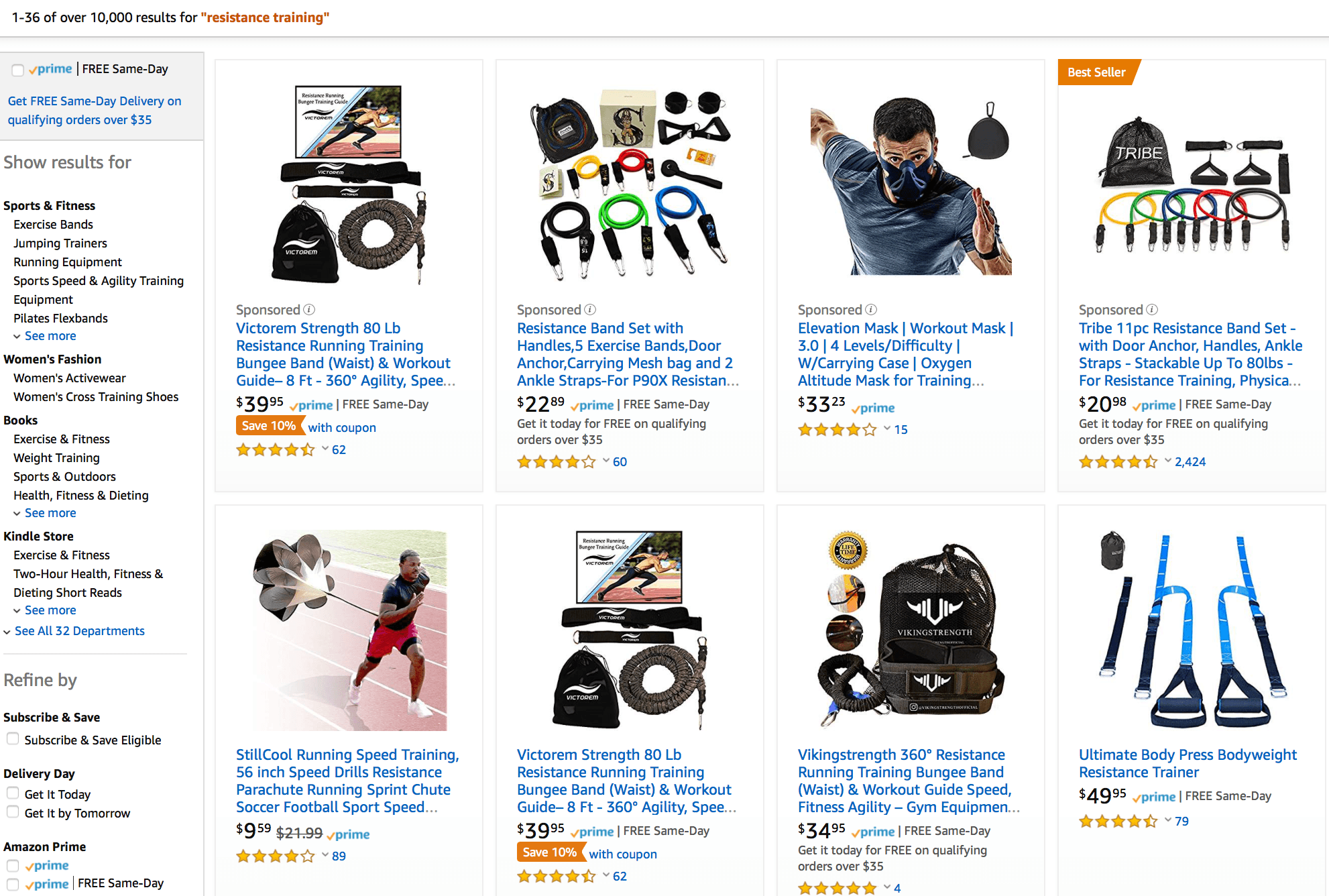Amazon Product Ads: Are They Right for You?
by Ana Gotter • June 18, 2018
People love Amazon. This is largely due to the sheer convenience, especially since prices are often slightly lower for a large number of products from other retailers. They can find almost any product from most brands right there, all with a few quick searches.
Businesses love Amazon, too. Being on Amazon expands your reach significantly, because now people are searching on Amazon for product research instead of just relying on Google. If you aren’t on the ecommerce site, you’ll miss those sales.
Even if you do have all your products listed on Amazon, though, there’s no guarantee you’ll get sales. The competition is fierce, with hundreds if not thousands of results for most generic searches. While products with high numbers of positive reviews slowly make their way to the front of the line, there’s another solution: product ads.
In this post, we’ll go over Amazon product ads and whether they’re right for your business, along with how to run great campaigns if you decide to invest in them.
What are Amazon Product Ads?
Amazon Product Ads work similarly to Google AdWords. You bid to have your product listing shown in searches with certain keywords or phrases and the winning bidders will have their ads shown at the top of search results pages.

Product Ads look just like other search results aside from a small “Sponsored” tag above the listing. They fit in seamlessly with the platform and other search results and the increased visibility on a platform where users are making both buying decisions and purchases is huge.
Pros and Cons of Amazon Product Ads
The potential payoff of Amazon product ads is huge. Literally. Having your product showcased at the top of search results on a site where users have their credit card info saved? That’s about as good as it gets and that’s the biggest pro to Amazon product ads. It also helps that you only pay when users click on your ad.
The cons all come in the technical side of things. These cons include:
- It takes longer to set up the ad campaigns than other platforms, including Facebook and Google, making campaign creation more cumbersome.
- Campaign reporting isn’t granular or as effective as you get with other platforms.
- If you don’t have a lot of product reviews, you’ll have a harder time getting placements.
- While advertisers can see if their selected keywords have a low, medium, or high keyword volume, they aren’t able to see how much of that volume they’re getting; this can make it harder to bid on and optimize the right campaigns.
Some brands have had great success with Amazon product ads, while others have found it frustrating because of its interface and relative lack of information available to advertisers. It’s all about whether or not the payoff is worth it for you.
How to Create Killer Product Ads on Amazon
If you’ve decided to jump in head first with Amazon’s product ads, there are a few best practices you’ll want to keep in mind to help you create a killer campaign.
Meet the Qualifications
If you want to sell on Amazon, make sure you’re hitting the required qualifications up front.
https://giphy.com/gifs/much-advice-sarcastic-l4FszwOjExa4v9W3S
That would certainly help. These include having:
- An active professional Amazon seller account
- Product listings that are new, not used
- Product listings in at least one of the available advertising categories
- Ability to ship to addresses anywhere in the US
- Product listings that are eligible for Buy Box
Understand How to Use Keyword Bids and Search Terms
There are two different things you’ll see when you’re creating Amazon ads: keyword bids and search terms. Understanding the difference between these two phrases is important.
The keyword bid is the exact term that you’re bidding on.
The search term is the phrase users searched for. If the search term triggers a keyword that you’re bidding on, your ad could be shown to that user.
Let’s look at a semi-ridiculous example that brings this into context effectively. In the image below, Gandalf says he’s looking for “someone to share in an adventure.” That’s the search term. The keyword bid for this could be something like “adventure companion” or “travel buddy.”
https://giphy.com/gifs/the-hobbit-gandalf-ian-mckellan-eALp83w8p9KTK
As with Google AdWords, manual campaigns allow you to set up different keyword match types in order to control what searches your keyword could potential turn up in.
These include:
- Broad match, which shows your ad to users who have conducted a search similar to your keyword. If you searched for “running shoes” and they searched for “jogging shoes” or “running women’s shoes,” your ad could still be shown.
- Exact match, which only shows your ad to users who have searched for your exact keyword. The keyword “running shoes” would only be shown to users who typed exactly that: “running shoes.”
- Phrase match, which can show your ad to users as long as your specific keyword is listed as a phrase. The keyword “running shoes” could therefore trigger on searches for “women’s running shoes” but not “shoes for runners.”
Use Negative Match to Weed Out Irrelevant Placements
Negative keywords allow you to decide what searches you don’t want your ad to show up in. They give you more control over your placements, decreasing the likelihood of irrelevant placements and clicks that can subsequently lead to wasted ad spend.
https://giphy.com/gifs/quentin-tarantino-pulp-fiction-john-travolta-3otPoSseb5VB61JZe0
Let’s say, for example, those running shoes you’re selling are available in all women’s sizes, except size 5. You could use the negative keyword “size 5 running shoes” in order to prevent your ad from being shown to users searching specifically for that. If you hadn’t specified that as a negative keyword, they likely would have clicked on your listing, only to not find what they want after they’ve cost you a click.
Wait it Out
One of the biggest mistakes that a lot of first-time advertisers make with Amazon product ads is actually giving up too early. If they don’t see results within three days, they’re out, and they allocate the money somewhere else.
https://giphy.com/gifs/filmeditor-the-princess-bride-xT9KVmZwJl7fnigeAg
Just like with other platforms, though, you need to give it some time. Some have actually found that it can take up to three weeks for a campaign to find its footing. As long as it isn’t destroying you with obscenely high ad costs, see if you can wait it out.
Conclusion
Amazon product ads are a little more cumbersome to create and monitor than other PPC platforms like AdWords and Facebook Ads, but if you have solid reviews on the platform and know that your audience is on Amazon ready to buy, it’s a good idea to at least try out the platform. As long as you keep your bids at what you can afford and utilize the right keyword match types to ensure your ads are placed in front of the right users, the risk is low and the potential reward is high.
As far as marketing campaigns go, those sound like decent odds.
What do you think? Do you use Amazon product ads for your business? Have you ever used them before? How do you think they compared to other PPC platforms? Share your thoughts and questions in the comments below.




